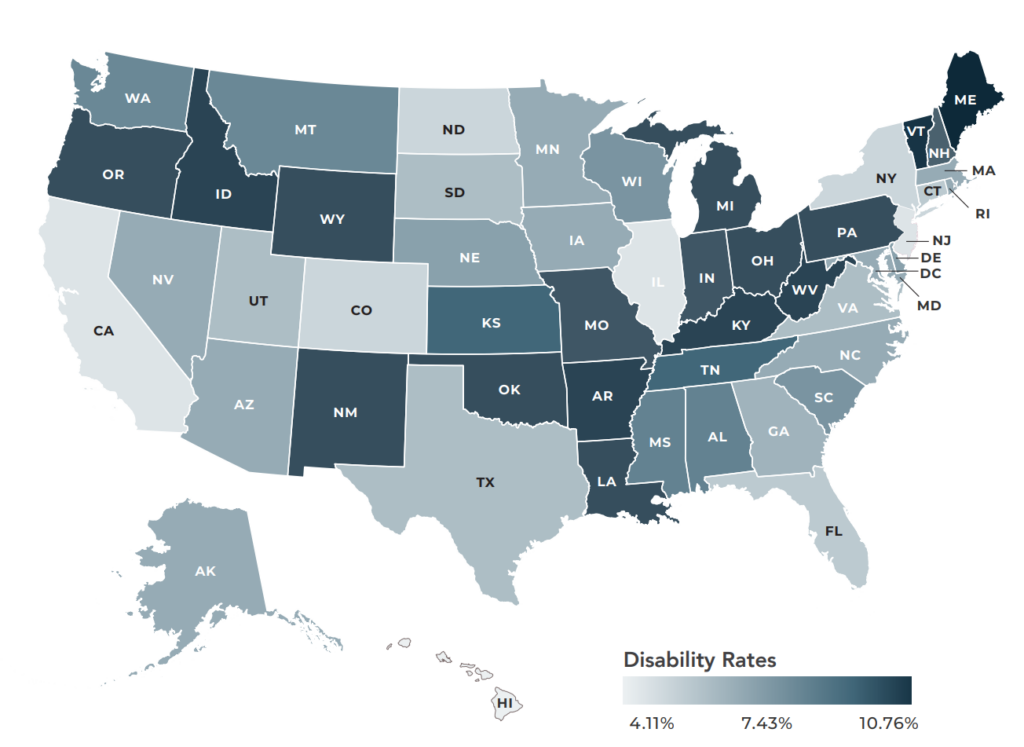About the Annual Youth Transition Report
IEL’s Youth Transition Report: Outcomes for Youth and Young Adults with Disabilities, published by the Institute for Educational Leadership (IEL), presents data that underscore the gap between youth with disabilities and those without disabilities on measures of success in education, employment, and poverty. The reports also include data on those opportunity youth whom the education and workforce systems have not adequately engaged, served, and supported.

What do the data tell us about youth and young adults with disabilities?
Data confirm that significant gaps remain between youth and young adults with and without disabilities in the education and workforce system, despite federal and state legislation and systematic efforts to improve opportunities.
The report presents the top and bottom five states across categories to examine more closely the differences that national averages may obscure. States with the lowest gaps may offer ideas on policies and practices for all states to consider; however, no state has entirely achieved full equity for youth and young adults with disabilities.
Achieving disability inclusion and equity requires the engagement of youth and young adults with disabilities, not only to inform the challenges in front of us, but also to solve those problems to ensure full inclusion of all people with disabilities across the country.
Highlights from the 2021 Youth Transition Report
Youth and young adults (ages 14-24) with and without disabilities are less likely than their peers without disabilities to complete high school, enter and complete college, enter the workforce, and attain financial success. A clear line can be drawn from low educational outcomes to low employment outcomes, including low wages and disengagement from the workforce. What begins as a 12.5 percent gap in high school attainment between youth with and without disabilities results in a poverty rate among people with disabilities that is more than twice the rate of those without disabilities. These continued gaps between young people with and without disabilities result from inequities in the education and workforce systems. Low employment and labor force participation outcomes culminate in a lifetime of lost wages and lost tax benefits for state and local communities. More importantly, the national workforce loses out on the creativity and contributions of people with disabilities.
The Youth Transition Report highlights the value of examining data to recognize whether we are accomplishing our goals as a nation to close achievement gaps and increase opportunities for youth and young adults with disabilities. Our national, collective approach must raise awareness of disability as a natural part of the human condition and promote people with disabilities who already serve as workers, leaders, creators, and inventors.
View the reports below:
IEL Youth Transition Report 2021
Suggested Citation: Cheng, L., & Shaewitz, D. (2021). The 2021 youth transition report: Outcomes for youth and young adults with disabilities. Washington, DC: Institute for Educational Leadership
IEL Youth Transition Report 2020
Suggested Citation: Cheng, L., & Shaewitz, D. (2020). The 2020 Youth Transition Report: Outcomes for Youth and Young Adults with Disabilities. Washington, DC: Institute for Educational Leadership.
IEL Youth Transition Report 2019
Suggested Citation: Cheng, L., & Shaewitz, D. (2019). The 2019 Youth Transition Report: Outcomes for Youth and Young Adults with Disabilities. Washington, DC: Institute for Educational Leadership.